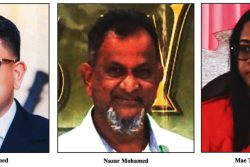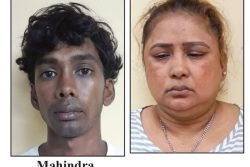Last year, on Thursday, December 8, a forty-three year-old fisherman left his residence to go “in search of a boat, hoping to catch a sail,” and make some money for the approaching holiday season.
Surujpaul Dindyal told his wife, Karan Bisal and their two small children goodbye and set off from their Melanie Damishana home on the East Coast of Demerara (ECD). ‘Boy’ or ‘Go Go man,’ as Surujpaul was called by everyone, never returned. ‘Boy’ would normally be gone for three or four days, at the most, at a time, and after a week had passed and he had not returned, Karan became very worried and made a missing person’s report at the Vigilance Police Station.
Another week passed, and with still no word from the police, Karan decided to place a missing person’s notice on one of the local television channels. Karan then received a telephone call from an officer who had seen the television bulletin, inviting her to the police station, where upon arrival she was informed that there had been an accident some time before and there was an unidentified body. The officer showed her a photograph of the unidentified man on his cellphone which she promptly recognized as her husband from the clothes that he was wearing and a tattoo on his arm.
The officer related that there had been an accident on Friday, December 9 at Buxton, ECD, and a man walking on the southern side of the road had been struck down. The injured man was rushed to the Georgetown Public Hospital (GPH) where he had been pronounced dead on arrival. The driver of the car which struck ‘Boy,’ had failed a breathalyzer test and was charged with driving under the influence (DUI). He claimed that two cars had been approaching from the east, and one had encroached on his lane and he had to swerve to avoid a collision, and in so doing, his car hit the pedestrian.
Karan, in the company of the police, set off for the GPH that very day. At the hospital’s mortuary they were informed that they had no record of any person matching the description of ‘Boy’. A check of the records of the Emergency Unit, where the injured man had been taken by the police following the accident, confirmed that the accident victim had been taken there and pronounced dead on arrival. So where was the body? Who had claimed it?
Karan claims that the police failed to make any headway with the investigation until the Criminal Investigation Department (CID) got involved in the case. It was only then that the mortuary staff admitted that the suspected remains of Surujpaul had “mistakenly” been subjected to “a poor burial” the following day after they had arrived at the hospital, along with four other unclaimed bodies of persons who had been deemed as destitute, in an unmarked grave at the Good Hope Cemetery, ECD.
On New Year’s Day, the Sunday Stabroek reported that the exhumation of the bodies was scheduled to take place on Tuesday, January 3. At the time of the discovery of this ‘mistake,’ the cemetery was flooded due to the inclement weather, and it was not until Friday, January 13 that all five bodies were exhumed. An autopsy performed on the body suspected to be that of ‘Boy’ revealed that he had died of multiple injuries. DNA samples were taken from ‘Boy’s suspected remains and sent abroad for confirmation.
‘Boy’s relatives were enraged, claiming that ‘a cover-up’ of some sort was taking place and demanded justice for the loss of their loved one. How was it possible for the body to have disappeared after only one day in the morgue, and there was no internal record of its arrival or departure from that department?
According to police sources, there are standard procedures for an incident of this nature, where an unknown person is killed in an accident. When an unidentified person is pronounced dead on arrival at the Emergency Unit, the body is labelled as a ‘John Doe,’ and a form, filled up by the attending doctor, seeks to provide as many details as possible, including gender, racial origin, height, approximate age, and distinguishing marks. The body is then tagged with the appropriate details of its arrival and sent to the morgue. As in ‘Boy’s case, there should have been a follow up by the traffic officer who was at the scene of the accident and accompanied the body to the hospital, to witness the autopsy which should have been performed soon after, to reveal the source(s) and the extent of the injuries caused by the accident.
After a ‘John Doe’ has been in the morgue for three or four days, the police would normally send out a bulletin, with the available details, along with a photograph of the deceased’s face to the media seeking their assistance in getting the public to help with the identification at the morgue. In this case, none of the procedures was followed.
A recent follow up by a reporter of this publication with the police revealed that the DNA samples taken from the suspected remains of ‘Boy’ have not been returned to the country as yet.
What really took place at the GPH morgue? Was there any internal investigation? How was the ‘John Doe’ suspected to be the remains of ‘Boy’ buried without a death certificate since an autopsy had not been performed on the body? Was there a cover up? By whom? For what reason? When will the DNA samples be returned? When will ‘Boy’s’ family have closure? Will they receive any compensation for their sad loss? There are just too many questions and no answers here.
Certainly, at a minimum the GPH should have undertaken an investigation into what happened, then taken action to deal with those responsible, and given some account to the family with an apology.
The drunk driver was charged with a DUI, but cannot be charged with causing death by dangerous driving since the body cannot be located.
It has been announced that the new police forensic lab would be able to do DNA tests eventually. Hopefully that will materialize not too far in the future, because there is an urgent need for such a facility, both to provide evidence in murder cases, as well as in others, such as that of ‘Boy’. While DNA samples have been sent out in the past to labs in Jamaica, Trinidad and most recently Brazil, for obvious reasons they are not handled with the dispatch which is important for us.
One year after Surujpaul left his home to go ‘look for a sail’ to earn some money to provide a good holiday season for his family, he is still ‘missing’ until the DNA tests confirm that the suspected remains are his own.
Will Surujpaul Dindyal’s family ever receive the justice they deserve?








